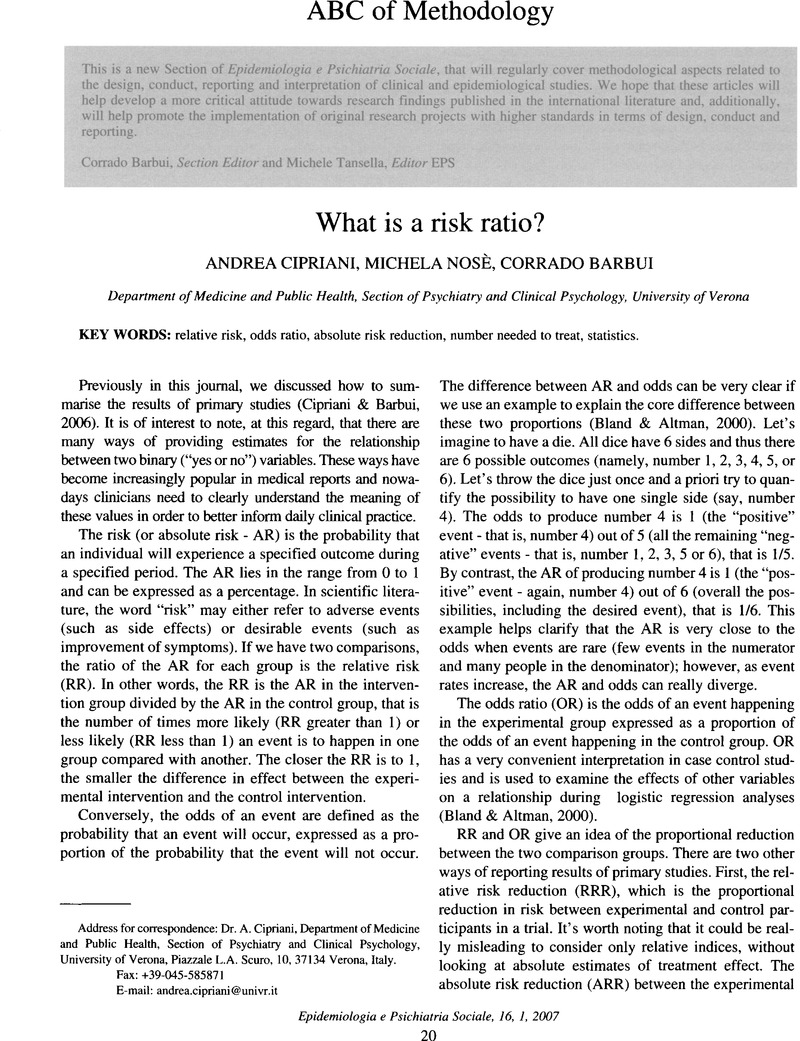Crossref Citations
This article has been cited by the following publications. This list is generated based on data provided by Crossref.
Accordini, Simone
2007.
An introduction to sample size calculations in clinical trials.
Epidemiology and Psychiatric Sciences,
Vol. 16,
Issue. 4,
p.
299.
Cipriani, Andrea
and
Barbui, Corrado
2008.
What is an intention to treat analysis?.
Epidemiologia e Psichiatria Sociale,
Vol. 17,
Issue. 1,
p.
26.
Cipriani, Andrea
Furukawa, Toshiaki A
Salanti, Georgia
Geddes, John R
Higgins, Julian PT
Churchill, Rachel
Watanabe, Norio
Nakagawa, Atsuo
Omori, Ichiro M
McGuire, Hugh
Tansella, Michele
and
Barbui, Corrado
2009.
Comparative efficacy and acceptability of 12 new-generation antidepressants: a multiple-treatments meta-analysis.
The Lancet,
Vol. 373,
Issue. 9665,
p.
746.
Santone, Giovanni
Ricchi, Gianmatteo
Rocchetti, David
Tofani, Stefania
and
Bellantuono, Cesario
2009.
Is the exposure to antidepressant drugs in early pregnancy a risk factor for spontaneous abortion? A review of available evidences.
Epidemiologia e Psichiatria Sociale,
Vol. 18,
Issue. 3,
p.
240.
Ma, Dongfeng
Zhang, Zhijun
Zhang, Xiangrong
and
Li, Lingjiang
2014.
Comparative efficacy, acceptability, and safety of medicinal, cognitive-behavioral therapy, and placebo treatments for acute major depressive disorder in children and adolescents: a multiple-treatments meta-analysis.
Current Medical Research and Opinion,
Vol. 30,
Issue. 6,
p.
971.
Huang, Yuanwei
Wang, Haidong
Luo, Ganfeng
Zhang, Yanting
Wang, Li
and
Li, Ke
2017.
A systematic review and network meta-analysis of neoadjuvant therapy combined with surgery for patients with resectable esophageal squamous cell carcinoma.
International Journal of Surgery,
Vol. 38,
Issue. ,
p.
41.
Long, Ling
Zhao, Hao-tian
Shen, Li-min
He, Cong
Ren, Shan
and
Zhao, He-ling
2019.
Hemodynamic effects of inotropic drugs in heart failure.
Medicine,
Vol. 98,
Issue. 47,
p.
e18144.
Lv, Xin
Qi, Jiaqian
Zhou, Meng
Shi, Bingyu
Cai, Chengsen
Tang, Yaqiong
Pan, Tingting
and
Han, Yue
2020.
Comparative efficacy of 20 graft-versus-host disease prophylaxis therapies for patients after hematopoietic stem-cell transplantation: A multiple-treatments network meta-analysis.
Critical Reviews in Oncology/Hematology,
Vol. 150,
Issue. ,
p.
102944.
Ye, Dongman
Yu, Tao
Shi, Ji
and
Piao, Haozhe
2020.
Comparison of intraoperative magnetic resonance imaging, ultrasound, 5-aminolevulinic acid, and neuronavigation for guidance in glioma resection: A network meta-analysis.
Glioma,
Vol. 3,
Issue. 1,
p.
3.
Alshehri, Mansour Abdullah
Alzaidi, Jamal
Alasmari, Sultan
Alfaqeh, Ali
Arif, Mohammad
Alotaiby, Sultan Falh
and
Alzahrani, Hosam
2021.
The Prevalence and Factors Associated with Musculoskeletal Pain Among Pilgrims During the Hajj.
Journal of Pain Research,
Vol. Volume 14,
Issue. ,
p.
369.
Zhou, Huifeng
Fan, Junjie
He, Jie
and
Hu, Shaoyan
2022.
Comparative efficacy of 19 drug therapies for patients with idiopathic thrombocytopenic purpura: a multiple-treatments network meta-analysis.
Annals of Hematology,
Vol. 101,
Issue. 5,
p.
953.



